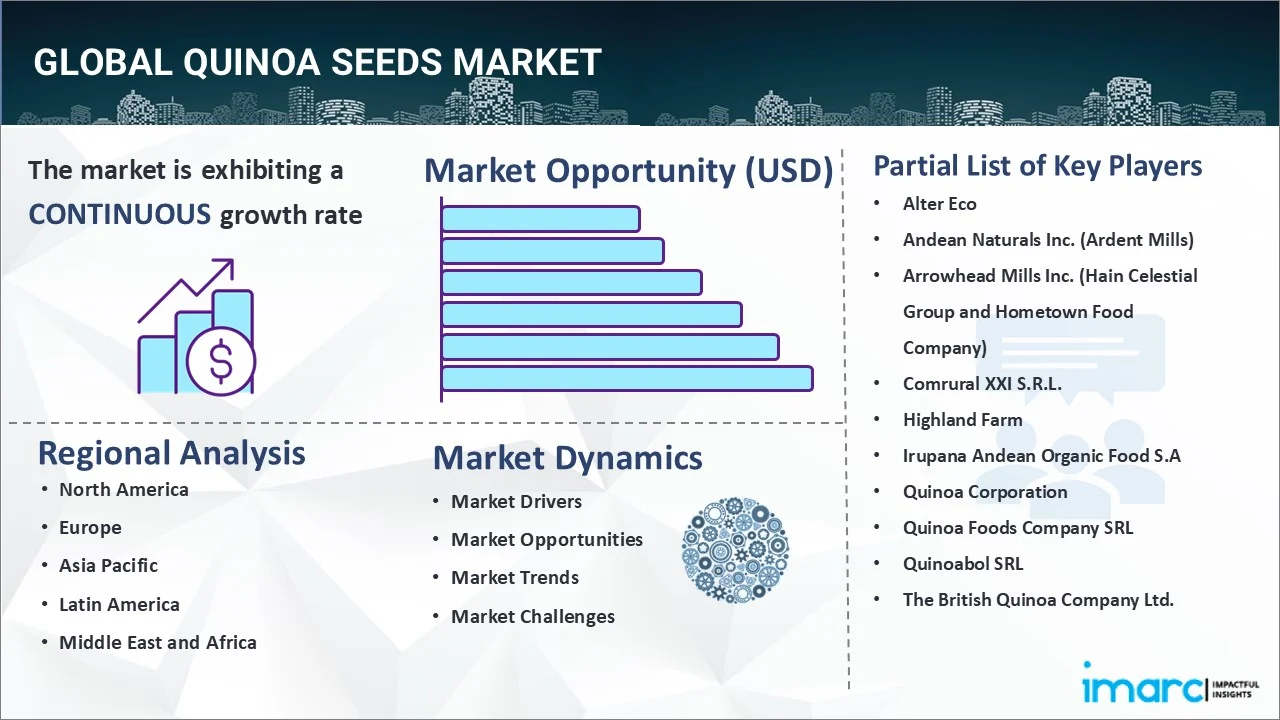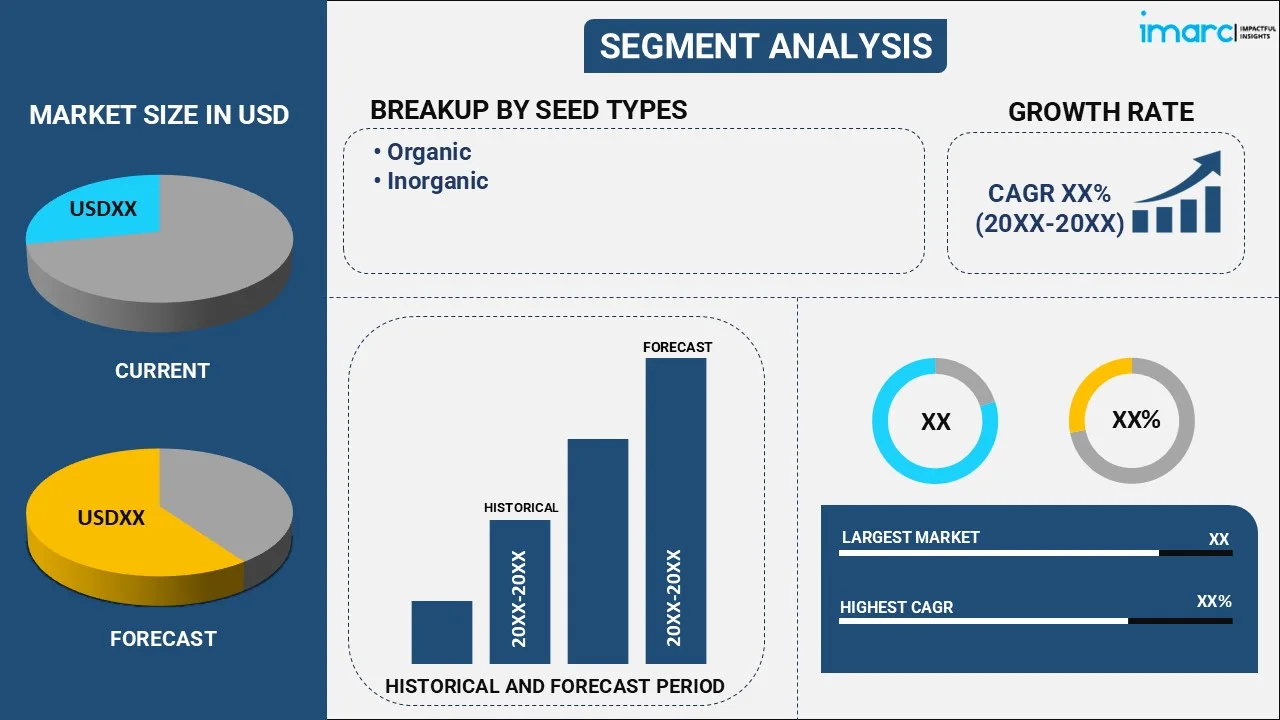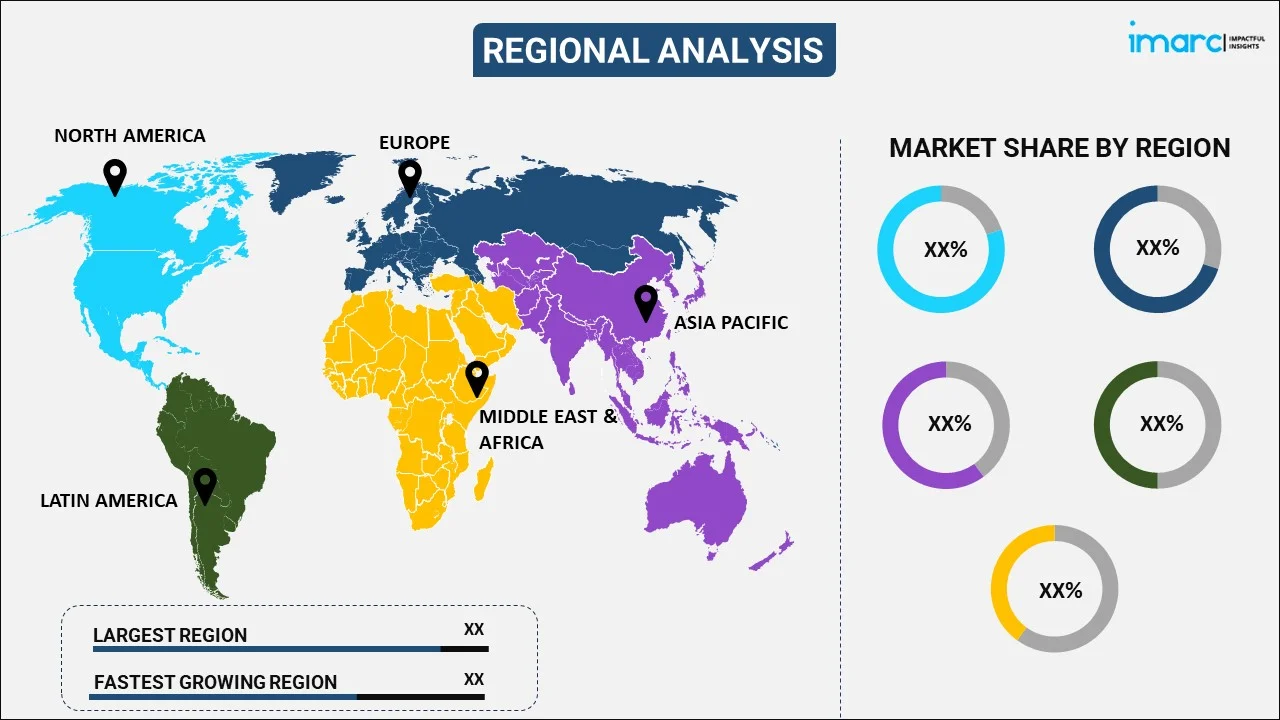
Quinoa Seeds Market Report by Seed Type (Organic, Inorganic), Type (White, Red, Black, and Others), Application (Direct Consumption, Processed Products), Distribution Channel (Online Stores, Offline Stores), and Region 2025-2033
Global Quinoa Seeds Market:
The global quinoa seeds market size reached USD 1.22 Billion in 2024. Looking forward, IMARC Group expects the market to reach USD 1.98 Billion by 2033, exhibiting a growth rate (CAGR) of 5.5% during 2025-2033. The increased awareness towards the nutritional benefits of consuming gluten-free products and the rising consumer preference for superfoods are propelling the market.
|
Report Attribute
|
Key Statistics
|
|---|---|
|
Base Year
|
2024 |
|
Forecast Years
|
2025-2033
|
|
Historical Years
|
2019-2024
|
| Market Size in 2024 | USD 1.22 Billion |
| Market Forecast in 2033 | USD 1.98 Billion |
| Market Growth Rate (2025-2033) | 5.5% |
Quinoa Seeds Market Analysis:
- Major Market Drivers: The rising expansion of organic farming practices accompanied by favorable government agricultural policies is positively impacting the market growth.
- Key Market Trends: The growing popularity of plant-based diets and the escalating demand for gluten-free products are bolstering the overall market.
- Competitive Landscape: Some of the prominent companies in the market include Alter Eco, Andean Naturals Inc. (Ardent Mills), Arrowhead Mills Inc. (Hain Celestial Group and Hometown Food Company), Comrural XXI S.R.L., Highland Farm, Irupana Andean Organic Food S.A, Quinoa Corporation, Quinoa Foods Company SRL, Quinoabol SRL, and The British Quinoa Company Ltd., among many others.
- Geographical Trends: According to the quinoa seeds market overview, Latin America dominates the market due to ideal growing conditions, traditional farming practices, and high-quality production facilities.
- Challenges and Opportunities: The high production costs are hindering the market. However, improving farming efficiency and adopting cost-effective cultivation techniques will continue to strengthen the market in upcoming years.

Quinoa Seeds Market Trends:
Continuous Product Innovations
Food manufacturers are increasingly using quinoa in a diverse variety of products, from snacks to beverages, owing to its nutritional profile and versatility. The innovation in quinoa-based products is expanding its presence in the market, thereby attracting consumers who are looking for healthier and unique food options. For example, in March 2024, NIUKE Foods introduced market-first quinoa milk as part of its new lineup of vegan products, alongside eight chickpea-based vegan mayonnaise varieties and other plant-based milk alternatives.
Growing Popularity of Plant-Based Diets
Quinoa has gained popularity, thereby representing the quinoa seeds market recent opportunities due to its high protein content and essential amino acids, as more consumers adopt plant-based diets. This trend is driven by the rising awareness of the health benefits of plant-based nutrition and environmental as well as ethical considerations, thereby making quinoa a staple in vegan and vegetarian diets. For instance, in July 2024, Kiwi Quinoa announced the launch of One Lavi, a saponin-free quinoa variety available to consumers in the United States. The brand, known for its superior wholegrain and red wholegrain quinoa with a nutty flavor, offers its nutritious, gluten-free products in the U.S. market.
Expansion of Organic Farming Practices
There is a growing trend toward the cultivation of organic quinoa, on account of the increasing consumer preference for natural products. Organic farming practices are being adopted to meet the demand for chemical-free, non-GMO quinoa, thereby catering to health-conscious consumers and aligning with sustainable agricultural practices. This is escalating the quinoa seeds market revenue. For example, in May 2024, the Prime Minister of Bhutan launched the One Country One Priority Product (OCOP) initiative that assists countries in leveraging their potential and identifying special agricultural products (SAPs), including quinoa.
Global Quinoa Seeds Industry Segmentation:
IMARC Group provides an analysis of the key trends in each segment of the market, along with the quinoa seeds market forecast at the global, regional, and country levels for 2025-2033. Our report has categorized the market based on seed type, type, application, and distribution channel.
Breakup by Seed Type:

- Organic
- Inorganic
Organic holds the majority of the quinoa seeds market share
The report has provided a detailed breakup and analysis of the market based on the seed type. This includes organic and inorganic. According to the report, organic represented the largest market segmentation.
Organic quinoa seeds are cultivated without synthetic fertilizers and pesticides, adhering to strict environmental standards that promote soil health and biodiversity. Moreover, the growing demand for sustainable and eco-friendly products has led to a significant rise in the popularity of organic quinoa. Some of the products launched via, “JIWA Farm to Table“are natural and organic.
Breakup by Type:
- White
- Red
- Black
- Others
Red holds most of the market share
The report has provided a detailed breakup and analysis of the market based on the type. This includes white, red, black, and others. According to the report, red represented the largest market segmentation.
Red quinoa seeds, known for their slightly nutty flavor and crunchy texture, are increasingly featured in health-conscious food products. For instance, brands like Bob's Red Mill have introduced red quinoa as part of their extensive grain offerings, positioning it as a versatile ingredient for salads, bowls, and even as a rice substitute. This is positively influencing the quinoa seeds market outlook.
Breakup by Application:
- Direct Consumption
- Processed Products
Processed products currently account for the majority of the quinoa seeds market demand
The report has provided a detailed breakup and analysis of the market based on the application. This includes direct consumption and processed products. According to the report, processed products represented the largest market segmentation.
The rising demand for ready-to-eat formats is augmenting the growth of the segment. For example, Annie's Homegrown launched a line of quinoa-infused mac and cheese.
Breakup by Distribution Channel:
- Online Stores
- Offline Stores
Offline stores hold the largest market share
The report has provided a detailed breakup and analysis of the market based on the distribution channel. This includes online stores and offline stores. According to the report, offline stores represented the largest market segmentation.
Offline stores cater to diverse culinary preferences. This makes it easier for customers to incorporate this superfood into their daily diets. Mainstream supermarkets like Kroger and Safeway cater to the trend. This is increasing the quinoa seeds market statistics.
Breakup by Region:

- North America
- United States
- Canada
- Asia-Pacific
- China
- Japan
- India
- South Korea
- Australia
- Indonesia
- Others
- Europe
- Germany
- France
- United Kingdom
- Italy
- Spain
- Russia
- Others
- Latin America
- Brazil
- Mexico
- Others
- Middle East and Africa
Latin America exhibits a clear dominance in the market
The market research report has also provided a comprehensive analysis of all the major regional markets, which include North America (the United States and Canada), Asia Pacific (China, Japan, India, South Korea, Australia, Indonesia, and others); Europe (Germany, France, the United Kingdom, Italy, Spain, Russia, and others); Latin America (Brazil, Mexico, and others); and the Middle East and Africa. According to the report, Latin America accounted for the largest market share.
Latin America dominates the quinoa market's recent price due to favorable growing conditions in the Andean region, where quinoa is native. These countries account for most production, leveraging traditional farming knowledge and practices. For example, Bolivia's Altiplano region is renowned for its high-quality, organic quinoa, which is exported globally. In addition, the increasing demand for organic and gluten-free products has further set Latin America's leadership in the market, with these countries being the primary suppliers of premium quinoa varieties.
Competitive Landscape:
The market research report has provided a comprehensive analysis of the competitive landscape. Detailed profiles of all major quinoa seeds market companies have also been provided. Some of the key players in the market include:
- Alter Eco
- Andean Naturals Inc. (Ardent Mills)
- Arrowhead Mills Inc. (Hain Celestial Group and Hometown Food Company)
- Comrural XXI S.R.L.
- Highland Farm
- Irupana Andean Organic Food S.A
- Quinoa Corporation
- Quinoa Foods Company SRL
- Quinoabol SRL
- The British Quinoa Company Ltd.
(Please note that this is only a partial list of the key players, and the complete list is provided in the report.)
Quinoa Seeds Market Recent Developments:
- July 2024: Kiwi Quinoa introduced One Lavi, a saponin-free quinoa variety available to consumers in the United States. The brand, known for its superior wholegrain and red wholegrain quinoa with a nutty flavor, offers its nutritious, gluten-free products in the U.S. market.
- June 2024: Michele's Granola partnered with SIMPLi to launch a limited-edition product incorporated with strawberry & red quinoa seeds.
- March 2024: NIUKE Foods unveiled its market-first quinoa milk as part of its new lineup of vegan products.
Quinoa Seeds Market Report Scope:
| Report Features | Details |
|---|---|
| Base Year of the Analysis | 2024 |
| Historical Period | 2019-2024 |
| Forecast Period | 2025-2033 |
| Units | Billion USD |
|
Scope of the Report |
Exploration of Historical Trends and Market Outlook, Industry Catalysts and Challenges, Segment-Wise Historical and Predictive Market Assessment:
|
| Seed Types Covered | Organic, Inorganic |
| Types Covered | White, Red, Black, Others |
| Applications Covered | Direct Consumption, Processed Products |
| Distribution Channels Covered | Online Stores, Offline Stores |
| Regions Covered | Asia Pacific, Europe, North America, Latin America, Middle East and Africa |
| Countries Covered | United States, Canada, Germany, France, United Kingdom, Italy, Spain, Russia, China, Japan, India, South Korea, Australia, Indonesia, Brazil, Mexico |
| Companies Covered | Alter Eco, Andean Naturals Inc. (Ardent Mills), Arrowhead Mills Inc. (Hain Celestial Group and Hometown Food Company), Comrural XXI S.R.L., Highland Farm, Irupana Andean Organic Food S.A, Quinoa Corporation, Quinoa Foods Company SRL, Quinoabol SRL, The British Quinoa Company Ltd., etc. |
| Customization Scope | 10% Free Customization |
| Post-Sale Analyst Support | 10-12 Weeks |
| Delivery Format | PDF and Excel through Email (We can also provide the editable version of the report in PPT/Word format on special request) |
Key Benefits for Stakeholders:
- IMARC's industry report offers a comprehensive quantitative analysis of various market segments, historical and current market trends, market forecasts, and dynamics of the quinoa seeds market from 2019-2033.
- The research report provides the latest information on the market drivers, challenges, and opportunities in the global quinoa seeds market.
- The study maps the leading, as well as the fastest-growing, regional markets. It further enables stakeholders to identify the key country-level markets within each region.
- Porter's five forces analysis assists stakeholders in assessing the impact of new entrants, competitive rivalry, supplier power, buyer power, and the threat of substitution. It helps stakeholders to analyze the level of competition within the quinoa seeds industry and its attractiveness.
- The competitive landscape allows stakeholders to understand their competitive environment and provides insight into the current positions of key players in the market.
Key Questions Answered in This Report
The global quinoa seeds market was valued at USD 1.22 Billion in 2024.
We expect the global quinoa seeds market to exhibit a CAGR of 5.5% during 2025-2033.
The rising number of health-conscious and lactose-intolerant populations, along with the increasing inclusion of quinoa seeds in vegan diets based on their numerous health benefits, is primarily driving the global quinoa seeds market.
The sudden outbreak of the COVID-19 pandemic has led to the changing consumer inclination from conventional brick-and-mortar distribution channels towards online retail platforms for the purchase of quinoa seeds.
Based on the seed type, the global quinoa seeds market can be segmented into organic and inorganic. Currently, organic quinoa seeds hold the majority of the total market share.
Based on the type, the global quinoa seeds market has been divided into white, red, black, and others. Among these, red quinoa seeds exhibit a clear dominance in the market.
Based on the application, the global quinoa seeds market can be categorized into direct consumption and processed products, where processed products currently account for the majority of the global market share.
Based on the distribution channel, the global quinoa seeds market has been segregated into online stores and offline stores. Currently, offline stores hold the largest market share.
On a regional level, the market can be classified into North America, Asia-Pacific, Europe, Latin America, and Middle East and Africa, where Latin America currently dominates the global market.
Some of the major players in the global quinoa seeds market include Alter Eco, Andean Naturals Inc. (Ardent Mills), Arrowhead Mills Inc. (Hain Celestial Group and Hometown Food Company), Comrural XXI S.R.L., Highland Farm, Irupana Andean Organic Food S.A, Quinoa Corporation, Quinoa Foods Company SRL, Quinoabol SRL, and The British Quinoa Company Ltd.
Need more help?
- Speak to our experienced analysts for insights on the current market scenarios.
- Include additional segments and countries to customize the report as per your requirement.
- Gain an unparalleled competitive advantage in your domain by understanding how to utilize the report and positively impacting your operations and revenue.
- For further assistance, please connect with our analysts.
 Request Customization
Request Customization
 Speak to an Analyst
Speak to an Analyst
 Request Brochure
Request Brochure
 Inquire Before Buying
Inquire Before Buying




.webp)




.webp)












